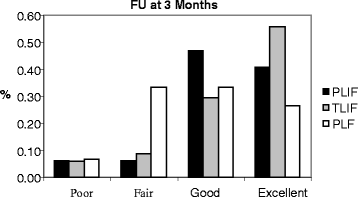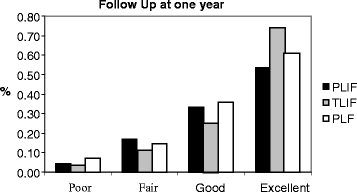Analytical comparison study of the clinical and radiological outcome of spine fixation using posterolateral, posterior lumber interbody and transforaminal lumber interbody spinal fixation techniques to treat lumber spine degenerative disc disease
- PMID: 26136814
- PMCID: PMC4487990
- DOI: 10.1186/s13013-015-0040-0
Analytical comparison study of the clinical and radiological outcome of spine fixation using posterolateral, posterior lumber interbody and transforaminal lumber interbody spinal fixation techniques to treat lumber spine degenerative disc disease
Abstract
Background: Degenerative disc disease is a common cause of chronic and disabling back pain that requires surgical intervention, posterolateral and posterior instrumental fixation (PLF), posterior lumber interbody fusion (PLIF) and transforaminal lumber interbody fusion (TLIF) are the techniques used to deal with such a problem.
Objective: To compare the clinical and radiological outcome of the variable surgical techniques used to deal with Lumber degenerative disc disease and to recommend the technique of choice.
Methods: 120 patients were treated between 2003 and 2010 at king Abdullah university hospital for lumber disc disease. The patients were divided into three groups: Group I (PLF n = 30 [59 levels]); Group II (PLIF n = 40 [70 levels]); and Group III (TLIF n = 50 [96 levels]). All patients had the same pre- and postoperative clinical and radiological evaluations (using Stanford score and local criteria and Oswestry Disability Index [ODI],). All cases had three months and then yearly for five years follow ups.
Results: There was no observed difference in the rates of intra-operative complications (Group I: 10 %; Group II: 8 %; Group III: 14 %; p = 0.566) and postoperative complications (Group I: 13.3 %, Group II:17.5 %, Group III: 18 % with p = 0.332). Among the groups. There was a vital decrease in the ODI scores over time (p < 0.005) but no major difference among the groups at different follow-up times. Radiographic fusion rates for Groups I, II and III were 90 %, 92.5 % and 94 %, respectively.
Conclusions: The surgical outcome of PLF, PLIF and TLIF used to treat degenerative disc disease is almost similar, there is no significant differences observed in complications and clinical outcomes. However, TILF may have better radiological outcome.
Keywords: Degenerative disc disease (DDD); Posterior lumber interbody fusion (PLIF); Posterolateral fusion (PLF); Spinal fixation; Transforaminal lumber interbody fusion (TILF).
Figures





References
-
- Fritzell P, Hägg O, Wessberg P, Nordwall A. 2001 Volvo award winner in clinical studies: Lumbar fusion versus nonsurgical treatment for chronic low back pain: a multicentre randomized controlled trial from the Swedish Lumbar Spine Study group. Spine (Phila Pa 1976) 2001;26:2521–2534. doi: 10.1097/00007632-200112010-00002. - DOI - PubMed
LinkOut - more resources
Full Text Sources
Other Literature Sources
Research Materials

